Attack, Defense, Stamina and Balance...
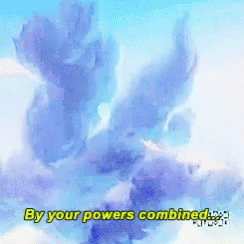 |
| I am an organized type chart! |
Now that I've gone through an overview to
help you decide on a launcher, let's go over another fundamental part of the
game, beyblade customization. One of the game's most appealing aspects is that
bladers are able to mix and match parts to make many different kinds of beys
for various purposes in battle.
Given all of the options we have with parts, beyblades usually fall under four different classifications or "types" that describe general playstyles. For bladers of previous generations, the type system hasn't really changed from Metal Fight and the original series' toylines, though now the burst finish is another factor to consider when building your beys.
Other various factors considered when deciding what type your bey is are things like weight, movement patterns, and spin time, though not every condition has to be met for their label. For now we'll take a look at the common traits each type has, their strengths and weaknesses and how they fare against other types, and also use stock examples that represent these various traits fairly well. Hopefully by the end of this you are able to better understand how each type works and can have a better idea of what to consider when customizing for and playing with each type.
Given all of the options we have with parts, beyblades usually fall under four different classifications or "types" that describe general playstyles. For bladers of previous generations, the type system hasn't really changed from Metal Fight and the original series' toylines, though now the burst finish is another factor to consider when building your beys.
Other various factors considered when deciding what type your bey is are things like weight, movement patterns, and spin time, though not every condition has to be met for their label. For now we'll take a look at the common traits each type has, their strengths and weaknesses and how they fare against other types, and also use stock examples that represent these various traits fairly well. Hopefully by the end of this you are able to better understand how each type works and can have a better idea of what to consider when customizing for and playing with each type.
Attack
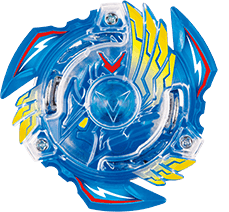 |
Let's start off with the most
popular type, attack. This type is usually the most recognizable due to the
dynamic movement inside the stadium. It's also used by almost every protagonist
across the different incarnations of the anime series. The goal of an
attack-type is to use great force to overpower opposing beys, hitting hard,
fast, and consistently enough to end games with over/burst finishes.
The movement comes from using a performance tip with a flat base. This generates friction to move around the stadium, building momentum for their attacks. The layer will have various ridges/protrusions to control where/how force is applied when making contact, and the disk may also distribute weight to match the contact points on the layer.
The overall weight is average or light when compared to other types, heavy enough to reduce the impact of recoil on itself while being light enough to reduce pressure on the driver to allow for more movement.
Victory Valkyrie/Valtryek V2 is one example of what attack-types can be like. It has various edges on the layer to direct how it's force is applied, the disk while light, is designed to push air downwards initially to have more force on impact (though in practice it's unable to do so), and the rubber driver adds on to friction for speed in exchange for a low spin-time, and gets faster with use since the spikes wear down and create a flatter and faster tip.
Attack-types have the lowest spin-times due to using a less stationary performance tip, while the uneven weight distribution also doesn't help keep the bey upright as it starts to slow down. This can be taken advantage of if the attack type fails to land hits on the opponent. Movement can also be hard to control with the driver making it vulnerable to over finishes as well.
The movement comes from using a performance tip with a flat base. This generates friction to move around the stadium, building momentum for their attacks. The layer will have various ridges/protrusions to control where/how force is applied when making contact, and the disk may also distribute weight to match the contact points on the layer.
The overall weight is average or light when compared to other types, heavy enough to reduce the impact of recoil on itself while being light enough to reduce pressure on the driver to allow for more movement.
Victory Valkyrie/Valtryek V2 is one example of what attack-types can be like. It has various edges on the layer to direct how it's force is applied, the disk while light, is designed to push air downwards initially to have more force on impact (though in practice it's unable to do so), and the rubber driver adds on to friction for speed in exchange for a low spin-time, and gets faster with use since the spikes wear down and create a flatter and faster tip.
Attack-types have the lowest spin-times due to using a less stationary performance tip, while the uneven weight distribution also doesn't help keep the bey upright as it starts to slow down. This can be taken advantage of if the attack type fails to land hits on the opponent. Movement can also be hard to control with the driver making it vulnerable to over finishes as well.
Defense
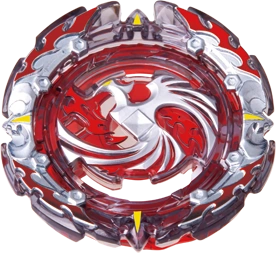
On the opposite end of the spectrum,
defense-types are intended to hold up against the best features of an
attack-type, minimizing the damage taken from attacks while also being able to
spin longer and wait for the opponent to wear down. One core aspect is that these beys are
heavyweights, to have resistance against recoil.
The performance tips have moderate movement with ball shapes or wide cones, giving enough stamina to outlast attack-types while also enabling movement for counterattacks or to dodge incoming attacks. The disk is designed to distribute weight more evenly and along with the layer, adds the most weight to the bey. The Layer is designed to be somewhat rounded to reduce recoil, but some ridges are included to enable counterattacks.
An example of a good defense-type be would be Dead/Dread Phoenix 0 Atomic. The layer is much rounder compared to an attack-type and features a gimmick where the outer armor can fall of instead of having the beyblade burst from an initial hard impact, allowing the remaining bey to be even rounder while conserving stamina. 0 is a fairly heavy disc that distributes weight evenly to further help with defensive properties, and the Atomic driver is a free-spinning ball to aid with stamina while allowing for moderate movement.
While it's designed to have more stamina than attack-types, defense-types don't have the most stamina as the weight puts pressure on the driver, and the components are not oriented to make the bey spin as long as possible.
The performance tips have moderate movement with ball shapes or wide cones, giving enough stamina to outlast attack-types while also enabling movement for counterattacks or to dodge incoming attacks. The disk is designed to distribute weight more evenly and along with the layer, adds the most weight to the bey. The Layer is designed to be somewhat rounded to reduce recoil, but some ridges are included to enable counterattacks.
An example of a good defense-type be would be Dead/Dread Phoenix 0 Atomic. The layer is much rounder compared to an attack-type and features a gimmick where the outer armor can fall of instead of having the beyblade burst from an initial hard impact, allowing the remaining bey to be even rounder while conserving stamina. 0 is a fairly heavy disc that distributes weight evenly to further help with defensive properties, and the Atomic driver is a free-spinning ball to aid with stamina while allowing for moderate movement.
While it's designed to have more stamina than attack-types, defense-types don't have the most stamina as the weight puts pressure on the driver, and the components are not oriented to make the bey spin as long as possible.
Stamina
Since spin-time is an aspect fairly important
to the game, it makes sense that there's an entire type dedicated to it.
Stamina-types really only have one goal, spin for as long as possible and win
the match with a spin finish.
The performance tip will have a pointed tip, either breaking into the wider cone or having a thinner design. This is done to minimize friction against the stadium by limiting how much contact is made while spinning and to decrease movement in order to conserve spin.
The disc will distribute weight evenly, and alongside the layer will have average weight to further limit friction on the performance tip, but have enough weight to handle some recoil. The layers will also be very rounded or have a design intended to further extend spin-time. The parts may also work together to enable Life-After-Death (LAD), where the bey is able to generate extra rotations after it has lost stamina and fallen on its side.
Deep Chaos/Caynox C3 4 Flow Bearing serves as a good example. The layer's shape helps to maintain stamina and the sloped ridges provide minor defense, 4 is a lighter weight that reduces pressure/friction, and bearing's free rotating tip along with its use of ball bearings helps to greatly increase the spin time.
While they spin fairly long, since friction is minimized and the design has less defense/offense to extend spin time, they are prone to taking more damage from beys that can generate recoil. They also make easy targets since they generally stay in the center of the stadium where they will move the least.
The performance tip will have a pointed tip, either breaking into the wider cone or having a thinner design. This is done to minimize friction against the stadium by limiting how much contact is made while spinning and to decrease movement in order to conserve spin.
The disc will distribute weight evenly, and alongside the layer will have average weight to further limit friction on the performance tip, but have enough weight to handle some recoil. The layers will also be very rounded or have a design intended to further extend spin-time. The parts may also work together to enable Life-After-Death (LAD), where the bey is able to generate extra rotations after it has lost stamina and fallen on its side.
Deep Chaos/Caynox C3 4 Flow Bearing serves as a good example. The layer's shape helps to maintain stamina and the sloped ridges provide minor defense, 4 is a lighter weight that reduces pressure/friction, and bearing's free rotating tip along with its use of ball bearings helps to greatly increase the spin time.
While they spin fairly long, since friction is minimized and the design has less defense/offense to extend spin time, they are prone to taking more damage from beys that can generate recoil. They also make easy targets since they generally stay in the center of the stadium where they will move the least.
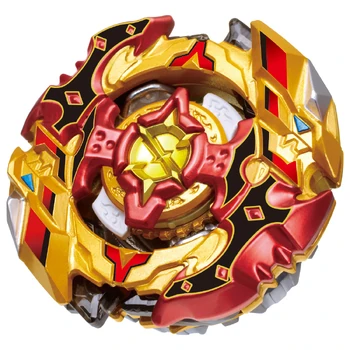
Following the main three types, Balance is
unique in the sense that it's a combination of the types mentioned above.
With a balance type, you use parts that combine traits from two or all three of
the other types and use their synergies to create a jack-of-all-trades of
sorts.
Due to their nature it's hard to pinpoint specific aspects of what classifies them, since the parts you want to use depending on what types you want to borrow from.
For attack traits, I recommend looking for layers that apply recoil, or drivers with a flat tip. For defense traits, heavier disks or layers that reduce the impact of recoil. For stamina traits, use more stable drivers or smooth and round layers to more evenly distribute weight.
Cho-Z Spriggan/Turbo Spryzen 0Wall Zeta' is able to use traits of all 3 types fairly well. The layer while corrugated is still rounded and has rubber to take hits and metal to dish out attacks. It can also alter between left and right rotation for further variation. 0 is a fairly heavy disc with the wall frame adding to the weight as well. Zeta' allows you to choose between a flat attack tip, a ball defense tip, and a sharp stamina tip to suit your matchups, while the stronger spring makes it harder to burst.
Using balance-types, one should be careful as the various traits implemented may not mesh well, resulting in a bey that is unable to do well in any aspect. While they are versatile, Balance-types are also masters of none, since having to use various traits means there's no one area it shines in. As such they are less likely to win against beys that take advantage of the types they've tried to implement, or beys that are clearly focused on one type. Overall, to use multiple traits the bey sacrifices the ability to be strong in one area, relying on its versatility to win.
Due to their nature it's hard to pinpoint specific aspects of what classifies them, since the parts you want to use depending on what types you want to borrow from.
For attack traits, I recommend looking for layers that apply recoil, or drivers with a flat tip. For defense traits, heavier disks or layers that reduce the impact of recoil. For stamina traits, use more stable drivers or smooth and round layers to more evenly distribute weight.
Cho-Z Spriggan/Turbo Spryzen 0Wall Zeta' is able to use traits of all 3 types fairly well. The layer while corrugated is still rounded and has rubber to take hits and metal to dish out attacks. It can also alter between left and right rotation for further variation. 0 is a fairly heavy disc with the wall frame adding to the weight as well. Zeta' allows you to choose between a flat attack tip, a ball defense tip, and a sharp stamina tip to suit your matchups, while the stronger spring makes it harder to burst.
Using balance-types, one should be careful as the various traits implemented may not mesh well, resulting in a bey that is unable to do well in any aspect. While they are versatile, Balance-types are also masters of none, since having to use various traits means there's no one area it shines in. As such they are less likely to win against beys that take advantage of the types they've tried to implement, or beys that are clearly focused on one type. Overall, to use multiple traits the bey sacrifices the ability to be strong in one area, relying on its versatility to win.
Specialist
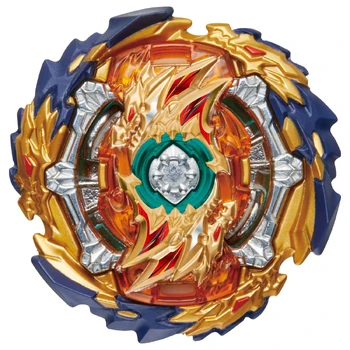 The last category I'll include is not
officially recognized, but I think it's distinct enough to mention. Simply
put, the specialist type is one used for beys that don't really fit within the
other four categories.
The last category I'll include is not
officially recognized, but I think it's distinct enough to mention. Simply
put, the specialist type is one used for beys that don't really fit within the
other four categories. I think of it as the opposite of a balance type. While the balance-type wants to use various traits from the other three types, a Specialist goes against all other types in favor of focusing on one specific aspect that isn't labeled by the other three categories. While the balance-type is a jack-of-all-trades, specialists are one-trick-ponies.
This can be a mechanic or gimmick that it chooses to build around and focus on for its strategy. However in a similar manner to balance types, the limit to building this kind of bey depends on what aspect you want to go for. It can include parts from the other types, but the main focus should be on what you want to specialize in. There's also a risk to building these beys since you may be lacking or forced to give up an aspect that's normally included by nature of being within the four more defined types.
Wizard Fafnir Ratchet Rise Sen is one example, where even though it's been officially labeled a stamina type, I feel it belongs in the specialist category. The wizard layer and ratchet disk use rubber and a plastic ring respectively, in order to absorb spin from right-spin beys, while the rise performance tip helps keep the bey upright to further enable spin stealing.
Due to their nature, specialists will be favored to win matches that they are designed to take advantage of, or that you've learned how to prepare for from experience. On the other hand they are also favored to lose match-ups that abuse their weaknesses, or where their weaknesses can be learned and taken advantage of. For example with Wizard Fafnir, the sen weight makes the bey somewhat unbalanced, and the ample amount of rubber used increases recoil and by extension, the chances for a self-caused over or burst finish as a result.
ConclusionGiven all the types, a chart that organizes them looks something like this:

Attack, Defense and Stamina are arranged in a
fashion similar to rock, paper, scissors, considering their pros and cons.
Balance is in the center and Specialist is outside the main four, fitting of
their traits. A summary of each:
- Attack: Uses high movement and recoil to win. Has advantage against Stamina-types since there's less resistance to their attacks, and the limited movement lets them set up easier. Disadvantaged against Defense-types due to the heavier weight, lower recoil, and moderate movement to avoid attacks.
- Defense: Uses heavier weight and lower recoil to reduce the impact of attacks while maintaining some stamina. Has an advantage against Attack-types due to holding out against their attacks. Disadvantaged against Stamina-Types since their own stamina isn't maxed out.
- Stamina: Uses
moderate weight alongside other parts to maximize spin times. Has an advantage
against Defense-types since there's less of a chance to prevent an endurance
battle. Disadvantaged against Attack-types since there's less resistance to an
over or burst finish.
- Balance: Uses parts to have traits from the aforementioned types in order to win through versatility. Advantage/Disadvantage depends on what traits are built upon, though it may also lose due to not being overly strong in one area.
- Specialist: Uses parts to ignore strategies from other types and focus on a more specific/unique aspect of the game to win. Advantage/Disadvantage depends on how much the opposing bey plays into/against your specifications.
While there's still the possibility of some beys performing better than others, with how much one can customize there's no such thing as a perfect bey. It's up to you to find what combinations suit you and how to adapt your strategy to account for their weaknesses, or the opponent's strengths.
- Balance: Uses parts to have traits from the aforementioned types in order to win through versatility. Advantage/Disadvantage depends on what traits are built upon, though it may also lose due to not being overly strong in one area.
- Specialist: Uses parts to ignore strategies from other types and focus on a more specific/unique aspect of the game to win. Advantage/Disadvantage depends on how much the opposing bey plays into/against your specifications.
While there's still the possibility of some beys performing better than others, with how much one can customize there's no such thing as a perfect bey. It's up to you to find what combinations suit you and how to adapt your strategy to account for their weaknesses, or the opponent's strengths.
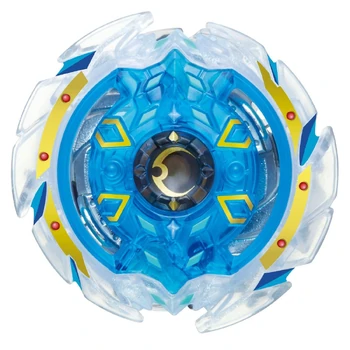
No comments:
Post a Comment